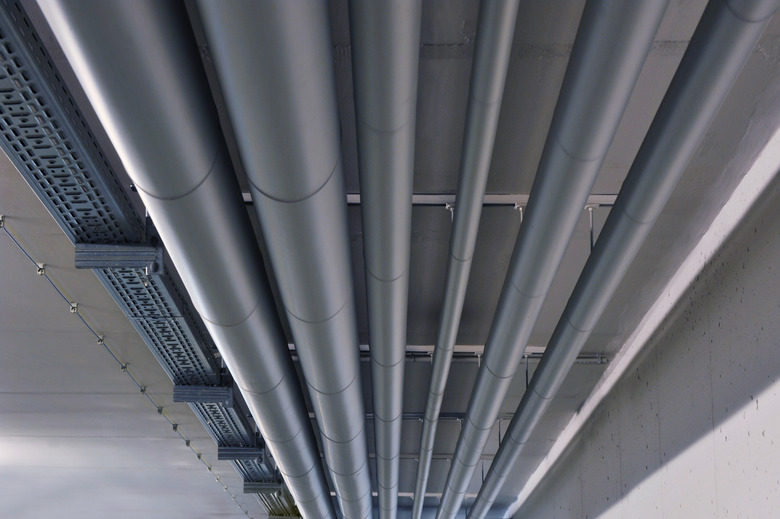How To Stop Condensation On Ductwork In A Basement
We may receive a commission on purchases made from links.
Just like the frost that forms on the side of a glass of ice water on a hot summer day, condensation forms on air ducts in hot, humid summer weather when the air conditioner is filling them with cold air. Condensation can also form of the inside of the ducts in winter when the basement is cold and the furnace is on. The phenomenon that causes it is the same one that makes it rain: Moisture precipitates out of warm air when it suddenly encounters cold air because cold air can't hold as much water.
A certain amount of condensate on metal ducts is inevitable, and in limited amounts, it probably won't do much damage. If condensate forms regularly for an extended period, however, it can cause the metal to corrode, and it can provide a substrate for mold to grow. The best solution is to cover metal ducts with duct insulation to reduce the temperature differential that causes condensation to form, but there are other things you can do as well.
Reduce Moisture in the Air
Reduce Moisture in the Air
If the air is less humid, it will be less likely to form condensate, but basements are notoriously humid places, and the air won't dry out by itself. It helps to seal any cracks around doors and windows through which outside air can enter using weatherproof caulk. If you notice white stripes and swirls forming on the walls, they are signs that moisture is seeping through from the groundwater, and you can inhibit this seepage by painting the walls with a good-quality moistureproof paint.
Air circulation also helps keep the air dry, so you might want to consider running an energy-efficient fan in the basement during the winter months when the furnace is working full time. In a worst-case scenario when nothing else seems to reduce condensate on the ducts, you might want to consider running a dehumidifier in the basement.
Improve Circulation in the Ducts
Improve Circulation in the Ducts
Condensation can be a sign that air isn't circulating efficiently in the ducts, and that can be the result of dirty air filters. You should clean or change the filters every three months on average, which will also improve the efficiency of your furnace or air conditioner. If you have filters placed behind the vent registers, you should clean or change them with the same frequency, especially if you notice blackening from mold or other signs of condensation. Professional duct cleaning usually isn't warranted, but if there's enough buildup to restrict airflow, consider calling a reputable duct cleaning company.
Leaky ducts don't circulate air efficiently, so if you find any joints in the ductwork through which air can pass, seal them with aluminum foil tape. It's also important to seal any gaps between the ductwork and the walls through which air can pass using caulk or trim.
Insulate With Duct Wrap
Insulate With Duct Wrap
Insulating the ducts is by far the most effective method to reduce condensation, and the job is easy if the ducts are exposed. Duct wrap, which consists of a layer of fiberglass insulation with a foil on one side, is pliable and easy to use. Wrap one layer around each section of ductwork with the fiberglass toward the exposed duct and secure it with aluminum foil tape. There's a good chance that doing only this will eliminate the condensation problem.
